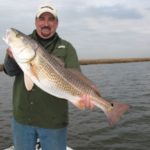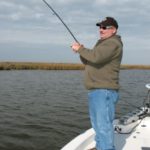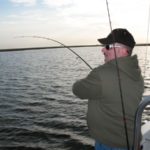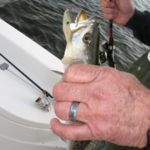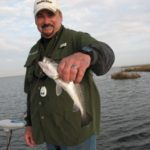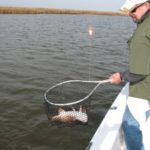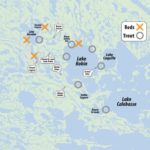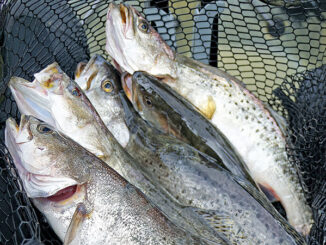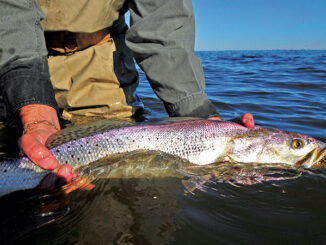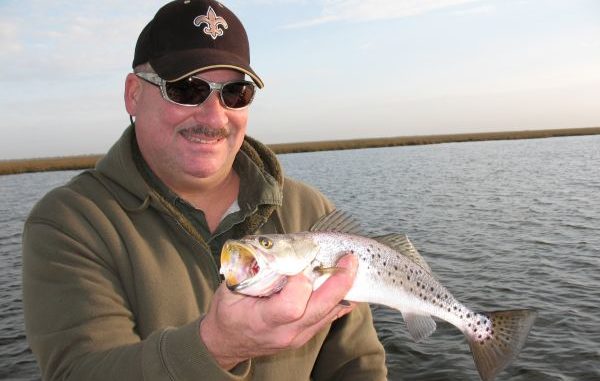
There’s more to March than great outdoor shows. Head to Hopedale’s inside lakes and bays to put together boxes of specks and reds.
If you’re a fisherman, “mediocre” is a good word to describe March. Webster’s says it means “average, ordinary, unexceptional, low in quality, second-rate and inferior.”
Pretty harsh.
To be sure, it’s not horrible, like the months of January and February can be with their frigid cold and exceptionally low water conditions. But it’s certainly not May and June, either, when our weather and fishing action turns on and becomes phenomenal down here in Southeast Louisiana.
It is what it is: March. An in-between month, and a transition month, when winter fades into spring and the fish we love to chase move from their deep winter haunts towards outside waters.
And it’s a moody month that can give us rapid swings in the thermometer, from hot to cold and to hot again in just the span of a few days. Those violent swings get our fish all discombobulated, and they run in circles like a dog chasing its own tail as they try to determine whether spring is coming or winter is staying.
That’s the challenge of March — it’s not really spring, but it’s not winter either.
But March doesn’t have to be mediocre; it can actually be a great month if you consider what March brings to the table.
First, this is “show month,” and this year there are back-to-back outdoor shows that’ll provide plenty to see and do. The Northshore Harbor Boat and Fishing Show in Slidell kicks off the show season on March 1-3, followed by the annual Boat Show in the Louisiana Superdome on March 7-10.
Then the huge Louisiana Sportsman Show & Festival and it’s accompanying Louisiana Sportsman Boat Show consumes the Lamar-Dixon Expo Center in Gonzales on the 14-17, so you’ll have lots to do and see in March.
But don’t forget the fishing, which can actually be great, even in March —if you know where to go and what to do.
I called on Hopedale Capt. George Ricks (985-630-2923), to show me how to take the mediocre out of March, and he was happy to oblige. We picked a day when the weather was milder and an easterly component to the winds pushed some water back into the marsh.
We rendezvoused at Ricks’ dock in Hopedale and loaded our gear into his 24-foot Nautic Star Bay boat. His nephew, Clayton Ricks, was accompanying us on our foray into Hopedale’s inside waters to see if the trout and redfish would cooperate.
Our route would take us through Hopedale Lagoon toward Lake Robin, where Ricks had a few favorite hotspots he wanted to try.
What to look for
“The first thing I look for is clean water,” Ricks said. “Everything can seem good about an area, maybe a good point or island or reef to fish, but if the water is dirty don’t waste your time. Keep moving until you find some decent water.
“Once you locate that, you look for other things. But the condition of the water is the reason I’ll be fishing on the east side of Bayou Terre Aux Bouefs this month.
“The west side of the bayou produced a lot of fish over the winter, but with the river up and the Caernarvon Diversion cranked open, that whole area will be flooded with cold, muddy river water, and that will push the fish out farther toward Oak River, Bakers Bay, Bay Lafourche and beyond. And it’ll push them east into areas like Tanasia Lagoon, Lake Amedee, Lake Robin, Lake Coquille and Lake Calabasse, where I intend to be fishing.”
Once you find clean water, Ricks said you want to look for any signs of baitfish activity in the water.
“Both trout and redfish will mainly be feeding on minnows, mullet and other baitfish,” he said, “so if you catch any sign of that, fish there.”
Water movement also is important.
“You want to look for current, especially good water movement around a point, over a reef, around marsh islands and cuts,” Ricks said. “Current is what moves the bait along, and predatory fish will hunt in a flowing current.
“You might not see much sign of bait in an area, but if the water is clean and there’s good current movement or a tide line, try it. You have to fish opportunistically, that is, don’t close your mind to trying a spot or an area you haven’t tried before.”
That doesn’t mean he’ll camp out.
“If the conditions are good, try it,” he said. “Give it 10 to 15 minutes, and if you get no hits, move on. That’s all the time I allow for an area to produce.
I like to stop at a good, promising spot, set the Power-Pole and fish all around it. But if 10 minutes passes without action, I’m gone. On to the next likely spot.”
Meanwhile, Ricks slowed the boat to a crawl and killed the outboard, allowing us to drift along with the current within casting distance of a broken-marsh shoreline. His instructions were simple: Cast on both sides of the boat, and we’d see if anybody was home.
Ricks said live bait is always preferable if you can get it, and most of the marinas should have some live cocohoes.
“I’ll fish two ways, depending on the current and the weather, and depending on the depth of the water,” he said. “If it’s cold, I’ll fish a live cocohoe minnow on a ¼-ounce jighead on the bottom.
“This time of year, I actually find fishing with a plain jighead more productive than using a sliding sinker or drop-shot rig. I think it’s because the cocohoes seem to wiggle a lot more fighting the weighted jighead rather than just a hook, but that’s just my theory.”
He targets waters he knows fish will use in their transition to outside waters.
“You’ll want to focus on deeper water, probably along one of the main routes the fish travel from the outside into the interior marsh — the same places you fished in the fall,” Ricks said. “They’ll use those same migration routes now for their exodus from the interior towards the outside bays.
“Anchor up at a likely spot and fish the ledges where you find current, clean water and hopefully signs of bait. Fish in all directions, give it 10 to 15 minutes, and if nothing bites, move.”
His second tactic is the addition of a cork to his rig — sometimes changing his bait.
“The other way I’ll fish in March is under a cork, using either live cocohoes or Hybrid Flurry soft plastics in the minnow magic or chartreuse glitter colors,” Ricks explained.
We were fishing with a combination of things. Ricks went straight to the sure thing — the live bait — and hung it about 18 inches under a cork, while his nephew tossed a beetle spin.
The water here was shallow, so theirs were sensible tactics.
I had a big, subsurface bait already tied on that I wanted to try, so I gave it several casts and worked it slowly back to the boat without it being noticed by any predatory species.
After a few minutes Clayton Ricks switched to live bait, and I switched to soft plastic, but it was the live stuff that got the first strikes. Capt. George caught a few decent-sized keeper trout, and then I got a good one on plastic. Clayton was next, with a few respectable trout.
“I actually prefer to fish with live minnows than live shrimp because the minnows are easier to keep alive and you can usually catch two or three trout on one minnow,” said Ricks. “That never happens with shrimp.
“It’s ideal when you can catch all you want on plastic, and often that’ll be the case this time of year. Lots of anglers don’t buy live bait at all in the early spring. But I like to take it along when its available because there are times when the fish are finicky and they won’t touch plastics.
“It’s also a good idea to take a pound or so of market shrimp along if you’re chasing reds.”
Although we were catching some trout, the action wasn’t the fast-and-furious type you hope for in the summer, and Ricks said this is pretty typical for specks in March.
“The key is to catch what you can and move to the next spot,” he said. “These fish are scattered all over, and you usually won’t find them ganged up in a single spot.
“But if you work at it, pick up two or three here and four there and three or four at the next spot, you’ll put together a decent box by quitting time. But you will work for them.”
Of course, there are other paths to pursue if trout just don’t cooperate.
“The other option, and my favorite March tactic, is to fish reds this month,” Ricks said. “The trout can be finicky and scarce, but redfish will generally always cooperate in March — and you can have a blast chasing them.”
And rocket science isn’t needed to hang these fish.
“If you want good redfish action, fish around the same points, marsh islands and cuts and coves, and along shorelines, casting your bait up close to the bank,” Ricks explained. “Reds will hit almost anything, so spoons, beetle spins, soft plastics and even topwater baits will produce when the conditions are favorable.
“But the sure-thing bait is live minnows or dead shrimp under a cork, fished in those areas.”
He said there are usually plenty of bull reds along the outside islands in Black Bay, around Stone Island, the Wreck, Iron Banks.
“Basically all the same areas you’ll be fishing for specks in the summer will hold bull reds right now, and they’ll be plentiful,” he said. “If the weather allows you to get out there.”
Ricks said the best way to fish for the big reds in outside waters is with a live minnow or dead shrimp on ¼-ounce jigheads fished on the bottom.
Meanwhile, we kept moving, sometimes anchoring with the Power-Pole at a promising spot and giving each spot 10-15 minutes to give us a reason to stay. When it produced, we stayed longer. When it didn’t, we moved.
Other times Ricks chose to drift, especially when we were near marsh islands and broken marsh shorelines. We’d stay the distance of a long cast from the bank, and we’d fish both toward the bank and toward open water: Reds were along the banks, and trout were scattered in the open water, so either species was a possibility with each cast — and we caught both.
A Power-Pole is a great feature in this kind of fishing, when the push of a button anchors you up and another push releases you to resume drifting, and it’s a feature Ricks used often.
By late morning we were headed back to the dock with a respectable box of fish, both reds and specks, and a great way for any angler to take the mediocre out of March.
* Capt. George Ricks can be reached at 985-630-2923.
Destination Information
Hopedale is about a one hour drive from Downtown New Orleans. Take Interstate 10 east from downtown and exit on I-510 south (Paris Road). Turn left on Highway 39 (Judge Perez Dr) and follow it until you cross the Violet overpass, and then take the first left at the four lane intersection (It’s just before the intersection with Highway 46. If you come to a T at Highway 46, you missed your turn).
Turn left on the four-lane, and follow it about nine miles to the four-way stop. Turn left again, stay on that road about five miles, cross the Ysvcloskey bridge and take a right to Hopedale or a left to Shell Beach.
Marinas
Breton Sound Marina has a double backdown, a hoist, ice, bait, accessories and a nearby fuel dock. The old Pip’s Place Marina is closed, but a few anglers still use the backdown — though the ramp is very steep, and it is inadvisable to launch there.
Campo’s Marina in Shell Beach offers double backdowns, ice, fuel and bait.
Maps/Charts
Standard Aerial Map No. 304
Guides & Lodging
Several excellent guides fish out of Hopedale and nearby Shell Beach. Check the ads in this issue or call the marina for recommendations.
Overnight accommodations are available in both Hopedale and Shell Beach. Check with the guides and marinas.

